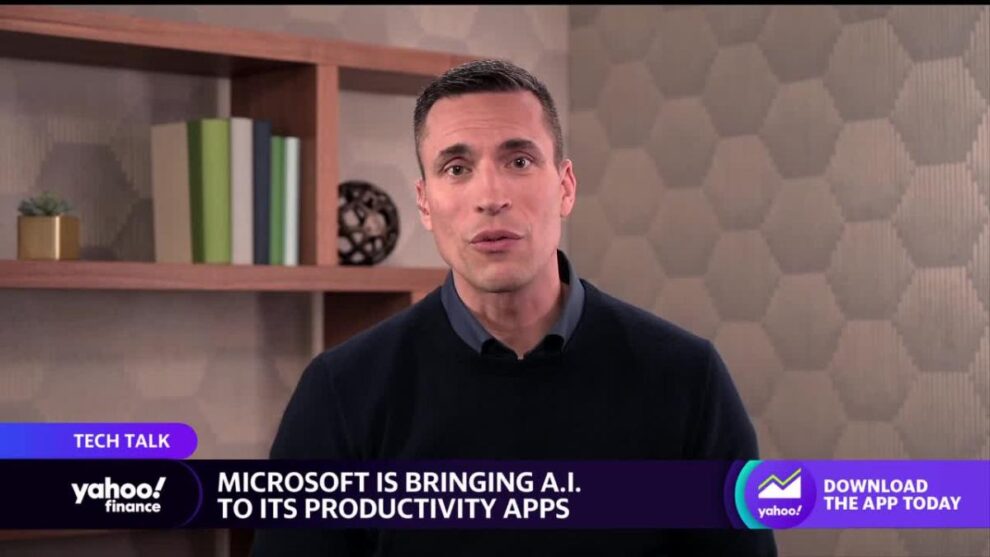Jared Spataro, Microsoft Corporate Vice President of Modern Work & Business Apps, joins Yahoo Finance Live to discuss the company’s AI integration and what it means for business and productivity.
Video Transcript
[AUDIO LOGO]
– The fierce battle for AI dominance is heating up, and tech giant Microsoft announcing today that it’s bringing its artificial intelligence capabilities to its Microsoft 365 productivity suite. For more, we’re joined by Jared Spataro, Microsoft corporate vice-president of modern work and business applications, and Yahoo Finance’s tech editor Dan Howley.
DAN HOWLEY: Jared, yeah, I thank you for having coming on the show today. I really just want to get out and explain what this announcement means for Microsoft, what you guys are doing with this AI in Microsoft 365. And just to give people an understanding, I know you, Microsoft, renamed it. But this is what was Office.
JARED SPATARO: Well, Dan, thanks for having me on the show. It’s great to be here with you. Yes, today we announced a new product that we’re calling Microsoft 365 Copilot. It is a copilot for your work.
And users will experience it in two different ways. They’ll see it show up within the context integrated into Word, Excel, PowerPoint, Outlook, Teams, and other apps that, as you say, are part of Microsoft 365. And then, also, we’ve introduced a brand-new experience that we’re calling Business Chat.
And you can think of this as a AI chat bot that has access to all of your data, your files, that works on your behalf and can help you do things that you’ve never been able to do before.
DAN HOWLEY: So what does that mean, right? I’ve looked at the release. I looked at the announcement, and we’re seeing the video on screen now. If I’m in, say, Word, I’m in PowerPoint, what does this assistant do, this copilot that you guys are calling it? And is it the same as what you have going on with Bing and the Edge browser or different?
JARED SPATARO: Well, let’s start with what it can do. So we’ll start in kind of a scenario that most people could relate to, being in Microsoft Word and working in a document. Copilot here can do a whole bunch of different things for you. It can help you get started if you just give it some inputs.
So in a business context, for instance, you can give it what we would call a prompt. So you’re asking it to do something. Please write a customer proposal.
And then you can feed it, Dan, some of your data. So you can say, based on these product specs, and incorporate these images. And it will actually then start to draft something for you.
Once you’ve got an initial draft, then it can help you to rewrite or to smooth or to edit. It can give you writing suggestions. And, finally, it can help with commanding or moving the apps to do what you need it to do by doing things like formatting.
So, in essence, this copilot idea– and the reason we’re using that word is to help you realize that you’re in the driver’s seat. It’s your job to get the work done. But this copilot can do quite a bit to automate some of those routine tasks.
Now, as you think about what makes it very different, it’s not quite as simple as taking some of these consumer technologies and plugging it right into the apps. We’ve created a pretty sophisticated system that brings together three foundational technologies. One is large language models, like you see from something like ChatGPT and Bing Chat.
The second is what we call the Microsoft Graph, and you can just think of that as access to all of your data– your emails, your files, your calendar, meetings. And the last one is the richness of those apps built up across 30-plus years. And when you put those three things together, you do tend to get some pretty magical scenarios.
DAN HOWLEY: So I want to ask– I’m sure you saw this, and I’m sure you noticed. Just before your Bing announcement in February, Google– I think it was February, yeah, February– Google came out and announced their Bard– really convenient timing there, maybe. But then, just ahead of this announcement, Google also announced something similar with their Workspaces apps.
I guess, what do you see this– as far as the competition goes, is it now kind of a new generation, an AI war that’s going on here, with you guys, Google, Salesforce talking about it? Is this the new frontier for companies when it comes to the productivity space?
JARED SPATARO: Well, we do think that this is a new era of AI. We think these generative AI technologies are really opening a new chapter, in particular for productivity, but for a whole range of scenarios. And we think that innovation is good for the markets, and competition in that innovation is even better.
So we do welcome the competition. We want to recognize that there are some incredible players out there. But I think competition is great for the market, and we’re going to do our best to focus on user needs, kind of what we can do to serve our customers, and then let them decide.
DAN HOWLEY: I guess, just as a final, when we talked about ChatGPT, we talked about Bing, there’s been, obviously, some growing pains with those. How are you working with that when it comes to these kinds of apps, where, you know, you’re doing your work, you know, you’re putting together a PowerPoint– by the way, where was this when I was in middle school and I had to do a PowerPoint? I didn’t want to do that then.
This would have been a lot easier. But I guess, you know, to the question, how are you dealing with those potential mismatches there?
JARED SPATARO: It’s a great question. It’s one of the most frequently asked by customers. There’s something that we can do in this context, Dan, that’s very different than a consumer context, and we call it grounding. And what that means is as we’re working with the AI, with the large language model, we can actually go down and ground it in your data. We can give it access to your data.
So as you ask it a question about your schedule, or you ask it a question about a meeting that you attended, it’s not making that up. It doesn’t have to come up with that out of thin air. But instead, it can go down to the data and use it as a reference point.
That helps a lot. It helps it because it gives it essentially the information that it needs to answer your questions and to actually do some analysis based on that data. So it’s not to say that the LLMs, this AI technology, it’s not to say they don’t make things up. But grounding puts them in a totally different context here within these commercial scenarios. And that makes it very, very different from what you see in ChatGPT or Bing Chat.
DAN HOWLEY: All right. Jared Spataro, Microsoft’s corporate vice-president of modern work and business applications, thank you so much for joining






